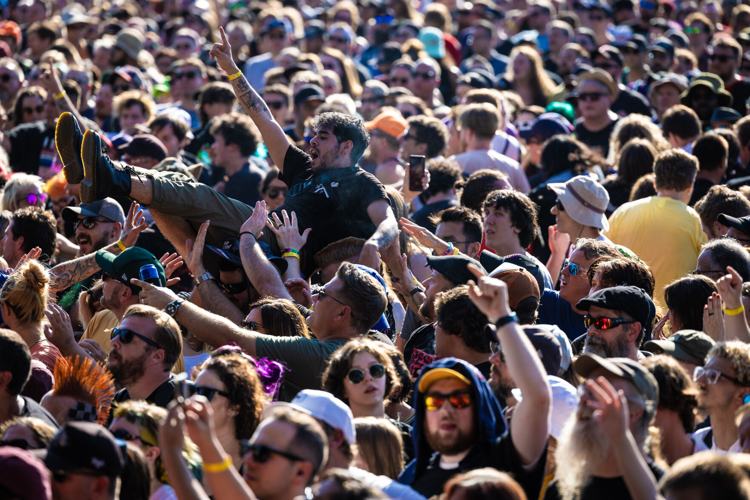Chicago’s reputation as a hub for music festivals is unmatched, with three of its largest events—Lollapalooza, Riot Fest, and the Chicago Blues Festival—drawing hundreds of thousands of attendees annually. Each festival has its own unique origin story, reflecting shifts in musical trends and the city’s cultural priorities.
Lollapalooza

Photo: Courtesy of Lollapalooza
Lollapalooza began in 1991 as a roaming showcase organized by Perry Farrell of Jane’s Addiction. Farrell’s intent was to create a multifaceted, multi-genre “tour of the summer” that would feature alternative rock, hip-hop, industrial, and emerging acts on each date of the itinerary, according to The Washington Post. The inaugural tour lineup included seminal acts such as Siouxsie and the Banshees, Nine Inch Nails, and Ice-T, and it stopped in more than 20 cities across North America. Despite its instantaneous cultural impact, the original touring model proved financially unsustainable, leading organizers to pause the festival after 1997.
After an eight-year hiatus, Lollapalooza was revived in 2005 as a destination festival in Chicago’s Grant Park, rather than as a traveling show, says Axios. Partnering with C3 Presents, Perry Farrell and his team transformed Lollapalooza into a four-day event designed specifically for downtown Chicago. In its first year back, Axios details, the festival attracted roughly 70,000 attendees per day and featured headliners such as Foo Fighters, The Killers, and Green Day. Over time, the festival expanded its footprint to include multiple stages, an art gallery, a “Lolla Cares” mission village, and a culinary pavilion showcasing local vendors, all set against Chicago’s skyline.
According to Britannica, Lollapalooza now draws in over 200,000 attendees, cementing its reputation as one of America’s largest music festivals. In addition to attracting major acts like Radiohead, Beyoncé, and The Strokes, Lollapalooza has become a platform for emerging artists who often move from smaller stages in Grant Park to global prominence within months.
Read more about the Lollapalooza 2025 lineup.
Riot Fest

Photo: Courtesy of Riot Fest
Riot Fest debuted in Chicago in November 2005, founded by promoters Mike Petryshyn and Sean McKeough, with a vision to celebrate punk, indie, alternative, and metal in a grassroots format. The first Riot Fest took place at multiple indoor venues, including Metro, Subterranean, and Double Door, over a three-day weekend; it featured influential punk and rock acts such as Dead Kennedys, The Misfits, and The Bouncing Souls, according to Riot Fest’s website. This multi-venue approach fostered a DIY ethos and cultivated a dedicated following among Chicago’s underground music community.
The Riot Fest website states that in 2012, the festival transitioned to Humboldt Park and rebranded as Riot Fest & Carnival, adding amusement rides, carnival games, and wrestling matches to its musical offerings. This expansion allowed the festival to draw over 50,000 attendees across three days and introduced a family-friendly dimension without sacrificing its punk ethos. Riot Fest has since become known for high-profile reunion sets, most notably The Replacements in 2013 and Jawbreaker in 2017, which underscored the festival’s role in punk lore.
Although organizers have faced community pushback over park usage, particularly regarding damage to grounds and concerns about gentrification, Riot Fest has worked with city officials to address noise complaints and mitigate disruptions, according to the Chicago Reporter. Despite moving to Douglass Park in 2015 due to Humboldt Park conflicts, Riot Fest remained a Chicago staple through the late 2010s before briefly relocating to the suburbs in 2024. Nonetheless, the festival reaffirmed its Chicago roots by returning to Douglass Park later that same year.
Read more about the Riot Fest 2025 lineup.
Chicago Blues Festival

Photo: Courtesy of Chicago Blues Festival
By contrast, the Chicago Blues Festival traces its origins to the city’s desire to honor its foundational blues heritage.
According to the city of Chicago Created in 1984 by Commissioner of Cultural Affairs Lois Weisberg—a year after the death of Muddy Waters, the “father of Chicago blues”—the festival opened on Butler Field in Grant Park with free admission to emphasize the blues’ democratic spirit. Early lineups paid tribute to Muddy Waters by featuring artists such as Eddie Taylor and James “Pookie” Young, many of whom had been directly influenced by the Delta blues migration to Chicago. As the event grew, it relocated to the Petrillo Music Shell in Grant Park, enabling multiple stages and expanded programming. In 2005, the same year Lollapalooza was firmly established, the Chicago Blues Festival moved to Millennium Park to accommodate larger crowds‘ says city of Chicago.
Today, held annually over four days each June, the Chicago Blues Festival attracts more than 500,000 attendees, making it the world’s largest free blues festival, according to Choose Chicago. It features performances by legendary artists such as Buddy Guy, Shemekia Copeland, and the Rolling Stones’ Keith Richards, as well as local up-and-comers who keep the city’s electric blues tradition alive. The festival also includes “Blues in the Schools” programs and panel discussions that examine how the Great Migration and Chicago’s urban environment shaped the evolution of the blues.
Read more about the Chicago Blues Festival 2025 lineup.
Together, these festivals solidify Chicago’s status as a dynamic epicenter for live music, where history and innovation coexist on some of the largest stages in the country.










(0) comments
Welcome to the discussion.
Log In
Keep it Clean. Please avoid obscene, vulgar, lewd, racist or sexually-oriented language.
PLEASE TURN OFF YOUR CAPS LOCK.
Don't Threaten. Threats of harming another person will not be tolerated.
Be Truthful. Don't knowingly lie about anyone or anything.
Be Nice. No racism, sexism or any sort of -ism that is degrading to another person.
Be Proactive. Use the 'Report' link on each comment to let us know of abusive posts.
Share with Us. We'd love to hear eyewitness accounts, the history behind an article.